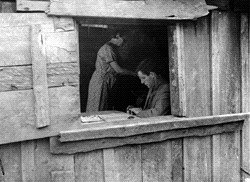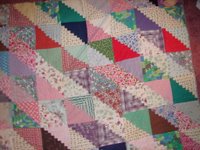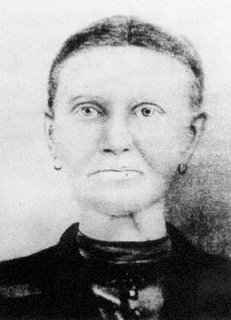Jackson McWhorter Skinner,

with brothers, uncles and neighbors, fought with the Confederate Army. Jackson was a private in the
62nd Mounted Infantry,
Company G. He entered the Army 16 May 1862 in Braxton County. A post-war source listed him as wounded in action 15 May 1864 at Battle of New Market. The wound he sustained at New Market never healed. His grandchildren remembered him as an invalid all his life.
New Market was a severe blow to the 62nd. Many men were killed, including local men, Privates
Andrew Heater and
Eli Sanders and Captain
Conrad Currence.
Jackson McWhorter Skinner was born 1843, d. 1891. He lived up Clover Fork and he was a farmer. He had a fair complextion, light hair and gray eyes. He stood 5'7". Jackson was the husband of
Patience Duvall and father of
Gideon, George Delbert (Dick), Annie, Clara, Lola, Lloyd, Ed and Earl
(Pappy). He was my grandmother's grandfather. He was the grandson of Alexander
and Catherine (Scott) SkinnerFor more on Patience and several of their children see the
Feb 15 '06 entry
Dick Skinner's Restaurant.May 28 '07 entry
Dick Skinner Milks a Cow
Footnotes1. The Battles and Campaigns of the 62nd Virginia Mounted Infantry, according to
http://www.alleghenymountain.org/solmain.htm#62nd were
~ Imboden's Tucker County, WV, Expedition, November 8-14, 1862
~ Jones'-Imboden's West Virginia Raid of April 1863
~ Gettysburg, July 1-3, 1863
~ Greencastle, PA, July 5, 1863
~ Williamsport, MD, July 5, 1863
~
New Market, May 15, 1864
~ Cold Harbor, June 3, 1864
~ Lynchburg Campaign, June 1864
~ Monocacy, MD, July 9, 1864
~ Bunker Hill, September 5, 1864
~ Third Winchester, September 19, 1864
~ Fisher's Hill, September 22, 1864
~ Woodstock, September 23, 1864
~ Cedar Creek, October 19, 1864
The regiment's
Organizational Assignments were:
1. March-July 1863: Northwestern Virginia Brigade, Department of Northern Virginia
2. July-Dec. 1863: Valley District, Department of Northern Virginia (Part of escort for ambulance wagon train during Lee's retreat from Gettysburg, and defended the wagons at the battle of Williamsport, MD, July 5, 1863.)
3. Dec. 1863-Jan. 1864: Imboden's Command, Valley District, Department of Northern Virginia
4. Feb.-June 1864: Northwestern Virginia Brigade, Department of Northern Virginia
5. Wilderness-Petersburg Campaign, May-June 1864: Wharton's Brigade, Breckinridge's Division, Third Corps (Lt. Gen. A.P. Hill), Army of Northern Virginia (The 62nd was detached from Imboden's Brigade and served with Breckinridge against Grant's offensive. The 62nd was returned to Gen. Imboden upon the latter's frequent requests.)
6. Battle of New Market, May 15, 1864: Second Brigade, Maj. Gen. John Breckinridge Commanding
7. June 1864-April 1865: Imboden's Brigade, Ransom's-Lomax's Cavalry Division, Valley District, Department of Northern Virginia.
 fabric pattern she needed and strong enough to carry the sack, she began sending me to pick up chicken feed for her at the Browns' warehouse. She would show me the fabric pattern she needed to finish her currect project and tell me to be sure to a sack with that pattern. (The Browns' general store was very small, so big things, like watermelons and sack of feed, were kept across the road in the post office/warehouse.)
fabric pattern she needed and strong enough to carry the sack, she began sending me to pick up chicken feed for her at the Browns' warehouse. She would show me the fabric pattern she needed to finish her currect project and tell me to be sure to a sack with that pattern. (The Browns' general store was very small, so big things, like watermelons and sack of feed, were kept across the road in the post office/warehouse.) 
 ? two sacks made a skirt.
? two sacks made a skirt.















